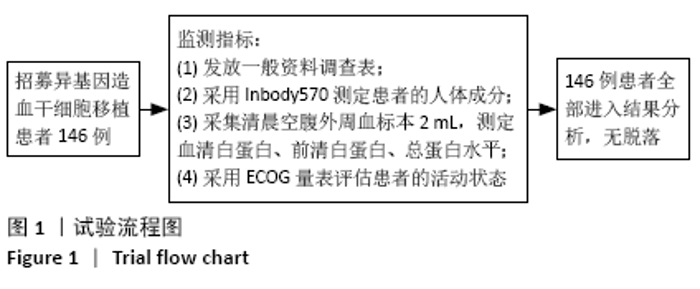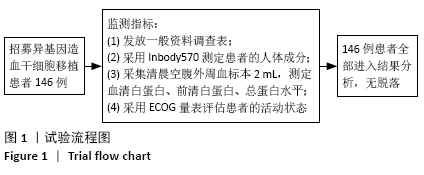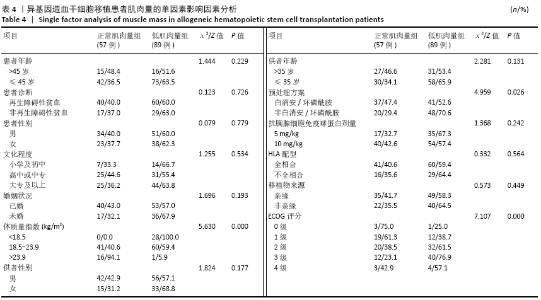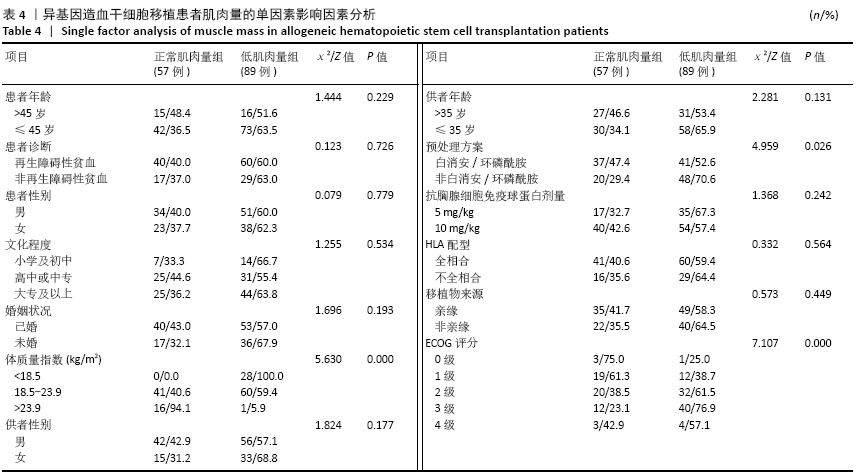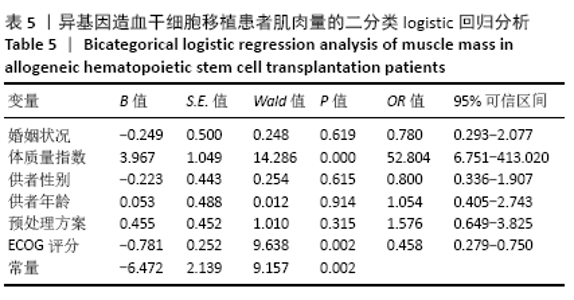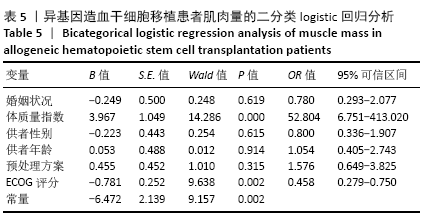[1] 黄晓军,吴德沛,刘代红.实用造血干细胞移植[M].北京:人民卫生出版社,2014:423-433.
[2] 张晓兰,叶宝东,姚斌莲,等.75例异基因造血干细胞移植患者营养状态调查[J].浙江临床医学,2016,18(12):2226-2227.
[3] OBATA H, IZUMI T, MITSUMA W, et al. Characteristics of Sarcopenia in Patients with Heart Failure. J Card Fail. 2014;20(10S):S160.
[4] 中华医学会骨质疏松和骨矿盐疾病分会.肌少症共识[J].中华骨质疏松和骨矿盐疾病杂志,2016,9(3):215-226.
[5] 钟文,谢春光,高泓,等.糖尿病与肌少症关系研究新进展[J].中国糖尿病杂志,2017,25(7):662-665.
[6] 刘聪慧,李忠心.肌肉衰减综合征与维持性透析[J].中国血液净化, 2019,18(11):760-762.
[7] URBAIN P, BIRLINGER J, LAMBERT C, et al. Longitudinal follow-up of nutritional status and its influencing factors in adults undergoing allogeneic hematopoietic cell transplantation. Bone Marrow Transplant. 2013;48(3):446-451.
[8] 金丕焕,曹素华.医学统计方法[M].2版. 上海: 复旦大学出版社, 2003:332.
[9] 美国东部肿瘤协作组.体能状态评分ECOG 评分法[J].中华普通外科文献(电子版),2012,6(6):556.
[10] CHEN LK, LIU LK, WOO J, et al. Sarcopenia in Asia: consensus report of the Asian Working Group for Sarcopenia. J Am Med Dir Assoc. 2014; 15(2):95-101.
[11] 马方,于康.营养科诊疗常规[M]. 2版.北京:人民卫生出版社, 2012:32-33.
[12] MORISHITA S, KAIDA K, TANAKA T, et al. Prevalence of sarcopenia and relevance of body composition, physiological function, fatigue, and health-related quality of life in patients before allogeneic hematopoietic stem cell transplantation. Support Care Cancer. 2012;20(12):3161-3168.
[13] 任广旭,李明花,余昌荣,等.造血干细胞移植术后患者营养状态与ECOG评分[J].中国医药导报,2017,14(35):50-53.
[14] HEINBOKEL T, FLOERCHINGER B, SCHMIDERER A, et al. Obesity and its impact on transplantation and alloimmunity. Transplantation. 2013; 96(1):10-16.
[15] 张冰花,何梦雪,沈南平.异基因造血干细胞移植患儿营养状况变化及其相关因素分析[J].护理研究,2018,32(20):3261-3265.
[16] 邢双双,顾则娟,蒋秀美.造血干细胞移植患者运动锻炼的研究进展[J].中华护理杂志,2018,53(2):242-247.
[17] HACKER ED, COLLINS E, PARK C, et al. Strength Training to Enhance Early Recovery after Hematopoietic Stem Cell Transplantation. Biol Blood Marrow Transplant. 2017;23(4):659-669.
[18] 胡世莲,方向.老年肌少症的评估及干预[J].中国临床保健杂志, 2017,20(2):113-117.
[19] 赵文利,闫洁,杨秀花,等.造血干细胞患儿移植初期的营养状况调查[J].中国食物与营养,2016,22(12): 83-85.
[20] 徐仁应,唐墨莲,万燕萍,等.住院肿瘤患者去脂肪组织测定及影响因素分析[J].上海交通大学学报,2014,34(7):1034-1038.
[21] DODDS RM, GRANIC A, DAVIES K, et al. Prevalence and incidence of sarcopenia in the very old: findings from the Newcastle 85+ Study. J Cachexia Sarcopenia Muscle. 2017;8(2):229-237.
[22] PIERIK VD, MESKERS CGM, VAN ANCUM JM, et al. High risk of malnutrition is associated with low muscle mass in older hospitalized patients - a prospective cohort study. BMC Geriatr. 2017;17(1):118.
[23] MITCHELL CJ, DELLA GATTA PA, PETERSEN AC, et al. Soy protein ingestion results in less prolonged p70S6 kinase phosphorylation compared to whey protein after resistance exercise in older men. J Int Soc Sports Nutr. 2015;12:6.
[24] TIELAND M, VAN DE REST O, DIRKS ML, et al. Protein supplementation improves physical performance in frail elderly people: a randomized, double-blind, placebo-controlled trial. J Am Med Dir Assoc. 2012; 13(8):720-726.
[25] 黄小江,骆天炯.肌少症危险因素及发病机制的研究进展[J].实用老年医学,2020,34(1):81-85.
[26] AKUNE T, MURAKI S, OKA H, et al. Exercise habits during middle age are associated with lower prevalence of sarcopenia: the ROAD study. Osteoporos Int. 2014;25(3):1081-1088.
[27] ROUBENOFF R. Catabolism of aging: is it an inflammatory process? Curr Opin Clin Nutr Metab Care. 2003;6(3):295-299.
[28] BLOISE FF, OLIVEIRA TS, CORDEIRO A, et al. Thyroid Hormones Play Role in Sarcopenia and Myopathies. Front Physiol. 2018;9:560.
|
